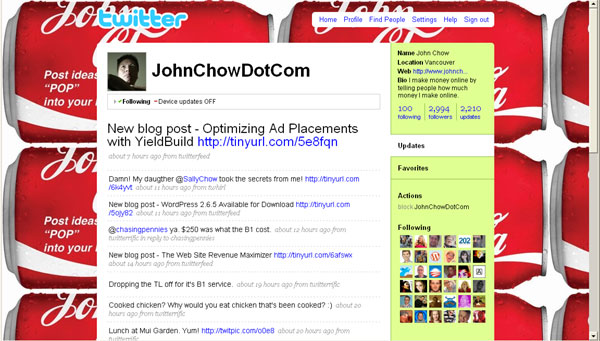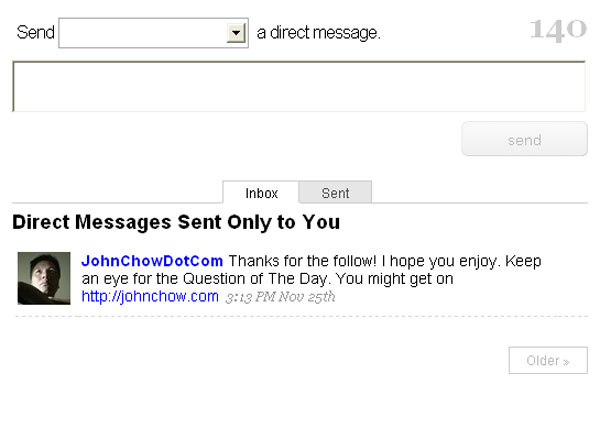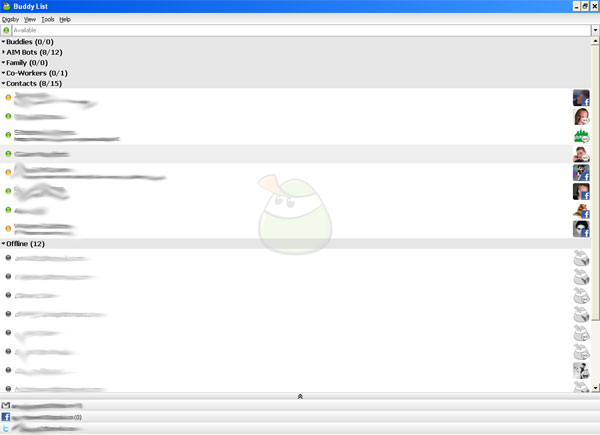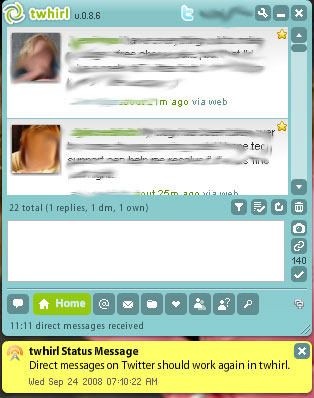Twitter is No Longer an Option. Why You Should be Tweeting.
 Twitter is kind of like Apple fandom - either you love it or you find it a dreadful inconvenience to interface with. In reality, Twitter is not a time-intensive scary monster or the be all and end all of social media. It is simply another tool that you can use to interact with your customers, or in the Twitter world, your followers.
Twitter is kind of like Apple fandom - either you love it or you find it a dreadful inconvenience to interface with. In reality, Twitter is not a time-intensive scary monster or the be all and end all of social media. It is simply another tool that you can use to interact with your customers, or in the Twitter world, your followers.
Given that everyone on here has a modicum of tech savvy, we'll just take for granted that you can set up an account on Twitter yourselves. We're here to help with the rest.
In our busy world governed by Blackberries and Iphones, Twitter is condensed information for the time-starved, internet savvy professional. It goes without saying that this is a very alluring demographic to attract and keep. If you consent to putting up a Twitter feed for your company, you will not only attract these eyeballs but brand yourself with an unwritten code of tech-savviness that they will understand. Let's put this in perspective. If Nike has a Twitter feed offering running tips, and Converse has nothing at all, which brand of sneaker would your Twitter follower buy when it came down to the checkout counter? The answer is academic.
Having a Twitter feed gives your company a certain sparkle over your competition that you simply can't buy. If your company has been around long enough, do you remember when there was an argument about whether or not you should have a website? This is the same argument. The question isn't whether or not your business should be on Twitter - the question is how fast can you get up and running on Twitter.
Setting Up Your Company Profile
In order to change your profile, log into your Twitter account and go to the "Settings" Tab at the top left. This will open up a sub-menu that allows you to edit your profile. If your company is all about you, find a professional looking picture of yourself and add it to your profile. If your company is larger, add your logo here.
You should also change your background image to something other than the default backgrounds and it should be something that relates to your company. Remember that it should also be something that functions well as a background image. If you are an architect, blueprints would go well here. If you are selling badges, a picture of a few of your badges would go well. Play around with a few different images until you feel that you have gotten it right. These two simple measures will make your twitter page look more professional.
[caption id="attachment_1017" align="alignleft" width="600" caption="Example of a Good Twitter Profile"] [/caption]
[/caption]
Following on Twitter
The most important thing to do on Twitter is follow. When you sign up for your account, go forth and search for anyone who is interested in your niche market and related areas. Start following all of them. An unwritten rule of Twitter is that you follow those who sign up to follow you, so this is how you initially gain your audience. Numbers are important, so try to add as many as possible in the first few days of your account going live.
Note that in order to search Twitter, you have to go to the bottom of the site and click on "Search". It also offers an advanced search feature similar to Google where you can refine your results according to date, area, and even whether or not a tweet contains links. To give you an example of how powerful this feature is, a search on web design yielded the following tweet:
"thinking about a web-presence makeover...blog design, website...everything!"
Can you say qualified lead that is dying for them to contact you? I knew you could.
Promote It Everywhere
Put your Twitter feed on your business cards, websites, brochures, and any other materials that you have out in the world. Your Twitter address is whatever you signed up for - for example if you signed up as webdesignnumberone your Twitter address will be @webdesignnumberone. Try to keep it as short as possible. Make sure that you also promote your Twitter feed on items like your Facebook group and your blog. Ask your employees to pimp the Twitter feed on their Facebook profiles if they want to.
Failing Twitter
Setting up a Twitter feed doesn't mean that your junior sales team gets to Twitter their thoughts at random to the world. The message must be managed as in all of your marketing. Hillary Clinton's campaign got Twitter wrong in the last election, allowing staff to spam Twitter and not following anyone. Twitter is all about interaction and if you aren't following, you aren't interacting.
If you are Twittering as a business you also have to be careful about the line between personal and social interaction. You don't want to get into a political argument if you are tweeting as a company. You do want to get into casual, light-hearted conversations that are related to your company or that help people out. For example, if you see a tweet from a follower requesting help with a layer command in Photoshop and you happen to know the answer, don't tweet but send a direct message to that user with the answer. Unless of course you are working for a graphic design firm, in which case you would tweet your reply. As long as you use common sense, you'll be on the right track.
[caption id="attachment_1058" align="alignleft" width="600" caption="Direct Message on Twitter"] [/caption]
[/caption]
Remember that all tweets can be searched on Twitter's website, so never Tweet anything offensive. It can turn up later and hurt you. If a Tweet does slip through your fingers that you don't like, you can always go back and delete it on your Twitter page.
Make Updating Easy With Apps and Cells
If you or your employees can't enter tweets with one click from the desktop, chances are good that you won't update as regularly as you should. You can download a tool called Digsby from digsby.com that not only will help manage your Twitter updates, but will handle incoming traffic from Facebook and all of your instant messaging clients. Once Digsby is set up, simply click on the Twitter logo on your menu bar to post a new tweet. That's it.
[caption id="attachment_1022" align="alignleft" width="600" caption="Digsby Contacts Window"] [/caption]
[/caption]
Another handy client with even more Twitter functionality than Digsby, including the ability to search tweets from your desktop, is Twhirl. It can be downloaded from http://www.twhirl.org/. While Digsby is a nice all-in-one app, the added functionality that Twhirl brings more to the table if you want to do more than just post new Tweets. Rocking both Digsby and Twhirl will give you the best results.
In order to communicate long URL's, sign up with http://tinyurl.com/. This will allow you to truncate URL's to keep them nice and short, which helps both for tweets and e-mails.
If you have company cell phones, make sure that Twitter is enabled for mobile updates on your cell phone and on the Twitter website itself. The only downside to this is that Twitter may currently only be updated from one cell phone number.
Send Thank You Notes
Log on to your account daily and send thank you notes on Twitter via direct message. Direct message on Twitter is similar to Facebook messages - private and not seen by anyone but your recipient. This personal touch will win you some kudos.
Keeping It Going
If you are having employees do the tweeting for you, make sure that you have your company Twitter feed set up on your desktop so that you can see messages the instant that they are posted. They may surprise you with their creativity and ideas.
Don't forget that Twitter will be taking up more of their time, so you will have to reassign some of their work load to another employee. They may underestimate the time that they will need at first and try to be a hero by saying that they should be fine doing tweets and their regular work - reassign their other work anyway just to make sure that you are paying enough attention to this new technology.
You may even want to assign the tweeting to a group of employees to make sure that you are getting multiple updates throughout the day - just make sure you don't do more than 3-4 tweets a day as a company. Likewise, you should avoid spammy promotion tweets unless they are to a real promotion or sale.
While having a Twitter feed as a company is all about promotion, you want to do it in a non-invasive and helpful way rather than fill the field of vision of your followers with spammy sale pieces. Don't forget to reply to the tweets of your followers and the people that you are following, particularly if you found something that they said to be interesting or relevant to your industry.
[caption id="attachment_1060" align="alignleft" width="194" caption="Your Taskbar on Digsby"] [/caption]
[/caption]
Don't be discouraged if someone doesn't like what you say or argues with you over anything that you say over a tweet. As with the nascent days of the internet, someone will always be there to call a business-related tweet "spammy". This doesn't mean that you did anything wrong and they can always opt-out of following you if they don't like the way that you are tweeting. You only want to pay attention if a few of your followers give you negative feedback on the same item. Using Twitter is a learning process and the community is, for the most part, forgiving. Like Facebook, the rules are simply to apply common sense to everything you do.
[caption id="attachment_1035" align="aligncenter" width="314" caption="Twhirl Window"] [/caption]
[/caption]
Writing a Good Tweet
Remember that you only have 140 characters to communicate with your followers so make it count. You really shouldn't be using more than one sentence to communicate your tweets - consider 140 characters to be the maximum, not what you need to use every time.
We've already gone over the fact that your Twitter feed shouldn't be spammy, but let's just reinforce the point. Spammy and irrelevant tweets will get you un-followed very quickly.
Help out people asking questions in your field, tweet short observations about news items that are light and upbeat and throw in the occasional bit about a sale or new product. As a twitterer, you are a member of a society and as long as you are viewed as a good member of that society, you will keep and gain followers.
Will Twitter Replace Blogs?
There's been a lot of rhetoric about this in the internet marketing community. In a word, no. You just aren't going to find something as informative as this article in a single tweet. It is useful to get an answer to a quick question, but beyond that stating that Twitter will replace blogs is simply not giving enough credit to the average internet user's attention span. There's a time for tweets and there is time for meat.
Just the Facts, Ma'am
As of October 2008 Twitter sported 2.25 million users. As of the same month, use of Twitter is growing faster than use of Facebook. You can guarantee that these people are all from a technically savvy demographic that you could probably liken to people who first got online back in the mid-90's. These are people who embrace new technologies and generally fit into a more affluent and educated demographic. There is no question that these are the people that you want to market your business to, unless you are selling funeral home packages.
Charging for Help on Twitter
A few people and businesses are trying to monetize Twitter by charging for answers to questions. This goes against the whole idea of Twitter as an inclusive and assistive community and isn't the best idea for business. Your best business use of Twitter is to build up and maintain a solid core of customers that think of buying your product over your competition based on the fact that your business is a tech-savvy member of their community. Immediate monetizing of Twitter by charging for answers to questions smacks of a superiority complex and will probably lose you more money in the long run.
Twitter may seem a bit time intensive at first. Once you get started you will find that the customer interaction that it invites is addictive and engaging. Keep your tweets interesting, your sales language light, and your eye on your customer's tweets in order to monetize Twitter successfully.















